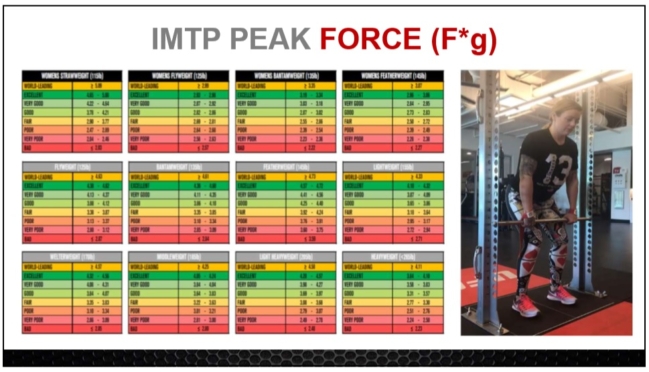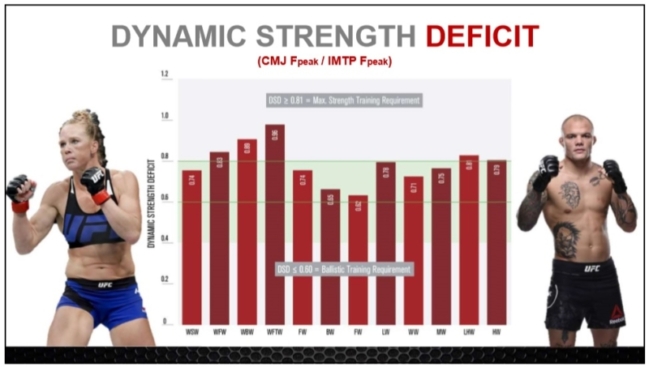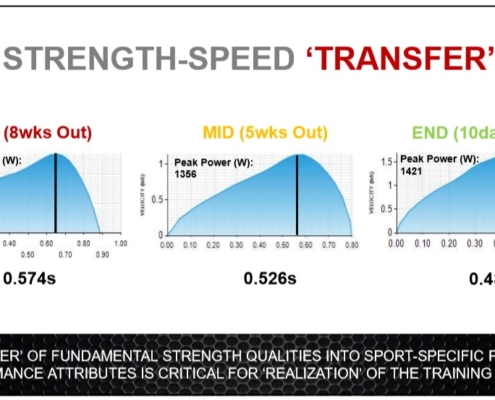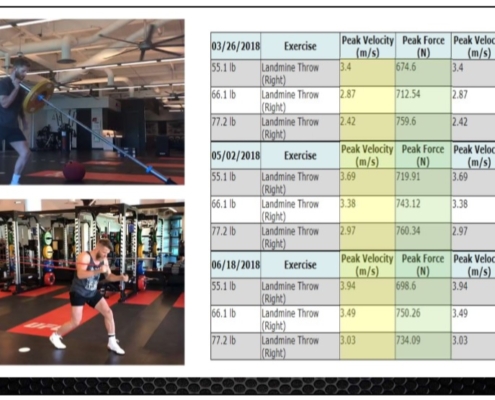Daz Drake on Maximal Strength Training
I have Duncan French to thank for putting me on to a journal article in his 2018 UKSCA UFC presentation- when he was going through his needs analysis for MMA. He actually didn’t even say much about it but as soon as I saw that slide a light bulb went off in my head and I knew when I finally got the copy of the presentation I needed to read the original journal article.
This blog is the cliff notes of the presentation Duncan gave and it sets up my rational for the importance of maximal strength. This blog will make it more clear what maximal strength will and will not directly help in sports performance.
I like the use of the word ”underpin” when referring to high force qualities and their relationship with high-velocity techniques. He then followed that up with this slide which featured the journal article I was talking about. If you want to get a copy of it for yourself click the link HERE.
What does this mean?
Well let’s start by exploring what these terms mean. Rate of Force Development (RFD) is measured as the slope of the Force-Time curve obtained during isometric contractions. This is important to study as the time allowed to exert force in a range of sports is typically very limited (~50-250ms). In contrast longer time is needed to exert maximum muscular force (>300ms).
Critically for this discussion, RFD in various time intervals from the onset of contraction is affected by different physiological parameters.
In the study above they examined the relationship between voluntary contractile RFD and (1) voluntary maximal muscle strength and (2) electrically evoked muscle twitch contractile properties. Maximal muscle strength is also known as Maximal Voluntary Contraction (MVC).
The main finding from the study was that voluntary RFD became increasingly more dependent on MVC and less dependent on muscle twitch contractile properties as time from the onset of contraction increased (Figure on the right).
Put another way, contractile RFD during the very early phase of muscle contraction (<50ms) is related to the intrinsic contractile properties of the muscle, whereas RFD during later time intervals (150-250ms) is related more closely to maximum muscle strength
The graph on the left indicates that the voluntary RFD measured at the time interval of 200ms was strongly correlated with MVC, where the explained variance (r=0.89) was 89%. This means that 89% of the variance in voluntary RFD at 200ms can be explained by the variance in MVC.
In conclusion this means Maximal Strength training has a great influence on Voluntary RFD >90ms especially around 150-250ms which we might define as Late RFD. So for things like acceleration in sprinting, jumping and change of direction maximal strength could have a big impact on directly enhancing sports performance. When it comes to things like the ground contact during top speed sprinting and unloaded striking and kicking, maximum strength could ”underpin” high velocity movement. However, training would need to be more targeted to early RFD training methods to improve these qualities.
How do you Measure Maximum Strength?
Now we know maximum strength is important how do you measure it? The traditional weight training method is to determine your 1 Repetition Maximum on a Back Squat or Deadlift.
You can calculate the Peak Force in Newtons once you convert your body mass into weight, and add the weight of the bar. A elite level of strength on the back squat might be around 2 x body mass so for a 85kg male (weight of 833 Newtons plus weight on bar of 1666 Newtons) that’s a total Force of 2,499 Newtons. This is sometimes represented as a unit of acceleration as a multiple of body weight, which in this case is 3.0 times body weight.
The back squat is limited by your concentric strength in the weakest part of the movement (the bottom of the descent). A preferred method to determine strength is using the isometric method. Elite levels on an Isometric Mid Thigh Pull (IMTP) are as high as 4.0 times body weight. We know that we can create more force isometrically than we can concentrically so a goal to aim for would be to develop 3.0 body weight concentrically and 4.0 body weight isometrically.
What’s next?
Having built Maximum Strength as measured by strength in the Isometric Mid Thigh Pull (IMTP), we need to transfer that strength into sport specific attributes. I’ll go into this in more detail in a follow up blog but this is the first time I have seen the concept of ”Dynamic Strength Deficit”
(CMJ Fpeak / IMTP Fpeak)
Using the results of the study by Kawamori_et al (2006) they recorded a Peak Force on the IMTP of 3,177 Newtons, and 1,449 Newtons on the Counter Movement Jump. Using this example the Dynamic Strength Deficit would be (1,449 / 3177) or 0.47 indicating extra training time should be spent on dynamic strength training.
In terms of Speed-Strength monitoring to see if the dynamic strength is improving, Duncan went on to share the initial findings they have been getting from the use of the Landmine punch throw– which I believe ”Boxing Science” first came up with.
In the next blog I’ll look a bit more in detail at the Power Protocol used here and the Jump profile I use in Tennis. This way you can profile you athlete in terms of Force and Velocity. I hope you have found this blog article useful and now understand how maximal strength can help improve sports performance.
Remember:
- If you’re not subscribed yet, click here to get free email updates, so we can stay in touch.
- Share this post using the buttons on the top and bottom of the post. As one of this blog’s first readers, I’m not just hoping you’ll tell your friends about it. I’m counting on it.
- Leave a comment, telling me where you’re struggling and how I can help
Since you’re here…
…we have a small favor to ask. APA aim to bring you compelling content from the world of sports science and coaching. We are devoted to making athletes fitter, faster and stronger so they can excel in sport. Please take a moment to share the articles on social media, engage the authors with questions and comments below, and link to articles when appropriate if you have a blog or participate on forums of related topics. — APA TEAM









